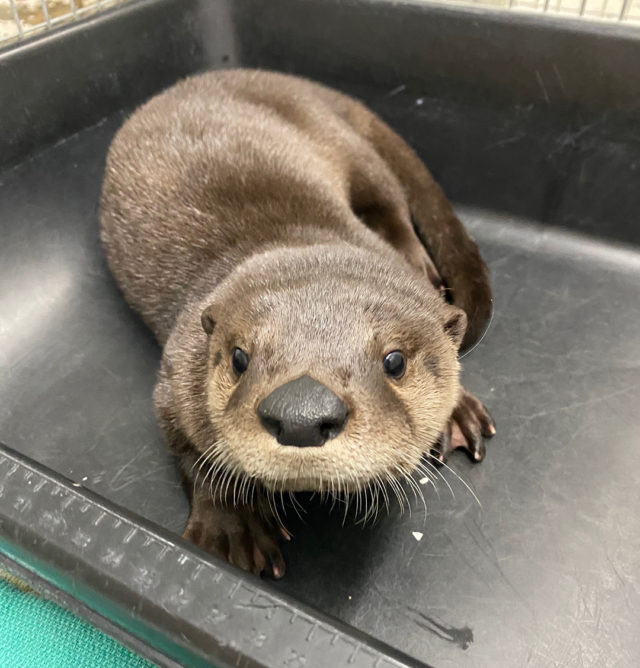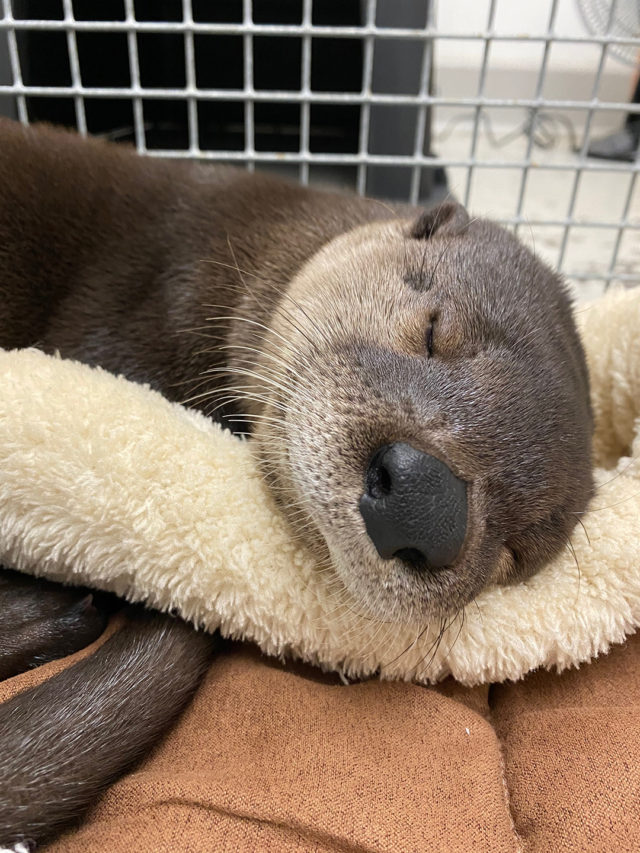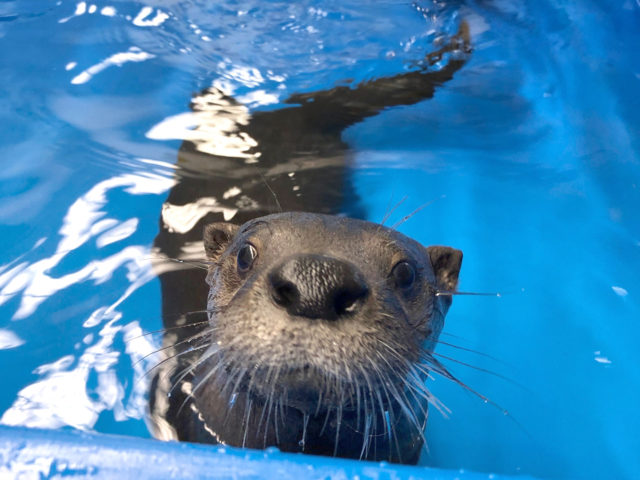Texas A&M SAH Team Faces Unique Challenges Treating Rescued Otter
Story by Megan Myers, CVMBS Communications

Fisher, the North American river otter, made quite a splash when he recently came to the Texas A&M College of Veterinary Medicine & Biomedical Sciences’ (CVMBS) Small Animal Hospital (SAH) for a dental procedure.
Though Fisher came in for a simple tooth extraction, his veterinary team discovered a much more serious problem under the surface. Luckily, the experts on his team were more than prepared to face any challenges in their way, including those unique to his species.
While North American river otters are native to Texas, they aren’t frequently seen by Texas A&M veterinarians; Fisher was only the seventh otter to visit the SAH in the past 22 years, so he provided a great opportunity for clinicians, staff members, and veterinary students to gain experience with a new species.
Fisher’s story began in North Texas, where he was discovered in the woods by a fisherman’s dog.
The fisherman took the pup to a local wildlife rehabilitator, who cared for him until he was a few months old, and then the Texas State Aquarium in Corpus Christi decided to adopt Fisher as a friend for their recently rescued otter, Arthur.
Because both pups were about the same age and had been around people too much to be released into the wild, they were a perfect match.
Once Fisher arrived at his new home, the Texas State Aquarium’s head veterinarian Dr. Taylor Yaw, a 2014 CVMBS graduate, performed a full medical exam and discovered what looked like a fractured tooth, which required surgery to fix.
Knowing the challenges associated with otter surgery, Yaw decided to bring Fisher to his alma mater to seek assistance from the SAH’s specialists in anesthesiology, dentistry, and exotic animal medicine.
Helping Each Otter Out
When Fisher arrived at the SAH, he was greeted by Dr. Ashley Navarrette ‘17, the CVMBS clinical assistant professor who oversaw his case. Though she was not experienced with otter medicine, she used her knowledge of similar small mammals to approach Fisher’s care.
“Otters fall into the family Mustelidae, which includes ferrets,” she said. “They’re in that realm, like ferrets, of seeming like a cat/dog hybrid as it pertains to their unique anatomy and physiology. But for the most part, we don’t extrapolate too much medicine from dogs and cats to otters; we use a lot of what we know about ferrets and weasels.”

Navarrette coordinated with anesthesiology specialists Drs. Keila Ida, a clinical assistant professor, and Sarah Jarosinski, a veterinary resident, to sedate Fisher and prepare him for surgery.
Once Fisher was asleep, they faced two challenges unique to otters.
“The biggest concern with otters is that unlike most dogs and cats, they don’t like to breathe on their own while under anesthesia,” Navarrette said. “You have to manually breathe for them either by depressing a reservoir bag or hooking them up to a ventilator, the former being what we did.
“The other major thing we had to watch for is that while dogs and cats often get cold while under anesthesia, it tends to be the opposite for otters,” she said. “The anesthetics actually push them the opposite direction and they can develop dangerous hyperthermia. Thankfully, Fisher didn’t have any issues with that.”
Once Fisher was stable under anesthesia, Dr. Bert Dodd, a CVMBS clinical professor and dentistry specialist, began the procedure.
Dodd usually spends his days treating dogs and cats and was excited to have the opportunity to work with an otter for the first time.
“It’s always fun to treat something a little different, but it’s also fun to see how similar they are to other species,” Dodd said. “The shape and amount of the teeth are a little bit different, but, overall, it was much like working with a small dog.”
When Dodd began his procedure, he was surprised to find that Fisher’s tooth wasn’t fractured—it was impacted in the jaw bone. As a result, Fisher was beginning to develop a dentigerous cyst, a slow-growing benign cyst surrounding the impacted tooth that can result in a broken jaw if left untreated.
“I located the tooth in the jaw after removing some bone and then took the tooth out and filled the socket back up with a bone-promoting product,” Dodd said. “The challenge was getting that tooth out of the bone without breaking the jaw. That’s always a scary part (of this procedure) and that’s one of the reasons most veterinarians don’t try to do this surgery.”
Thanks to Dodd’s expertise and years of experience, the surgery was successful and Fisher began a quick and seamless recovery.
An Otterly Bright Future

Now back home at the Texas State Aquarium, Fisher spends each day learning and playing in Otter Creek with his new best friend, Arthur.
“He is living the life,” Yaw said. “He has a group of eight trainers who will be taking care of him for the rest of his life, and he’s already started his training program. He’s definitely an eager learner.”
By training Fisher to open his mouth, roll over, and stay still on command, the aquarium’s trainers can make sure that his regular veterinary checkups are as easy and stress-free as possible.
As a permanent resident of the aquarium, Fisher plays a key role in educating visitors about wildlife conservation.
“We have North American river otters at the aquarium so people can learn about them,” Yaw said. “They are also a species that we’re actively trying to help preserve through our Wildlife Rescue Center.”
Fisher’s case may have been full of unique challenges and surprises, but thanks to Yaw’s foresight and the talented team of SAH veterinarians on his case, Fisher completely recovered and will enjoy his life of fun and games pain-free.
###
For more information about the Texas A&M College of Veterinary Medicine & Biomedical Sciences, please visit our website at vetmed.tamu.edu or join us on Facebook, Instagram, and Twitter.
Contact Information: Jennifer Gauntt, Director of CVM Communications, Texas A&M College of Veterinary Medicine & Biomedical Sciences; jgauntt@cvm.tamu.edu; 979-862-4216


